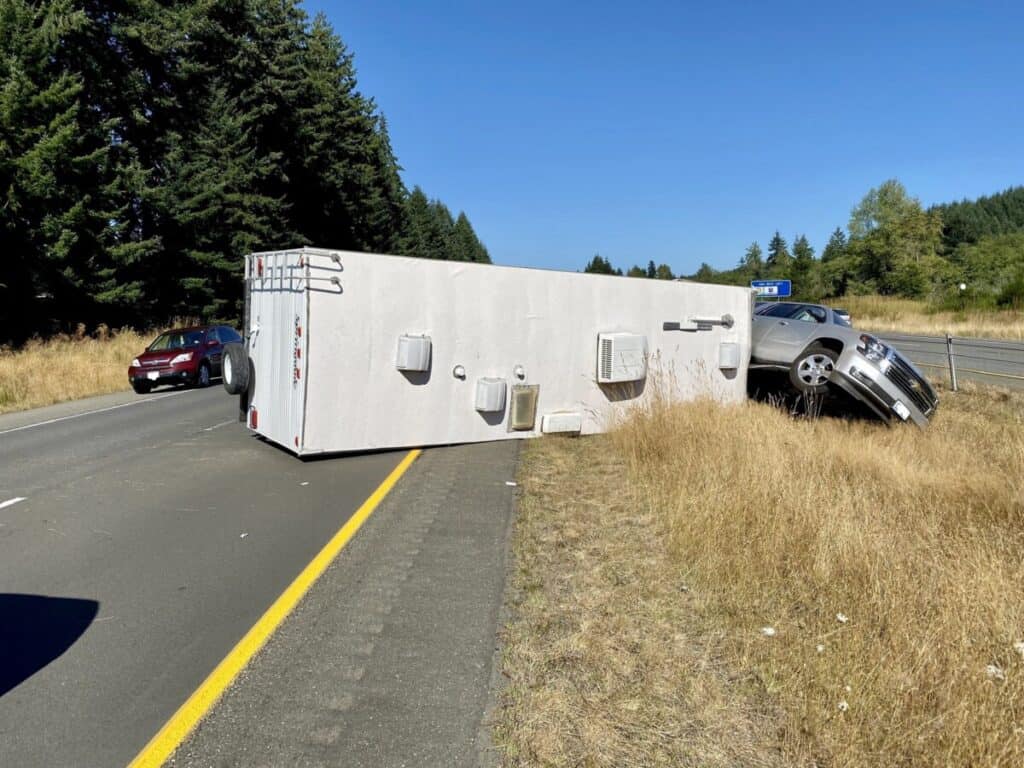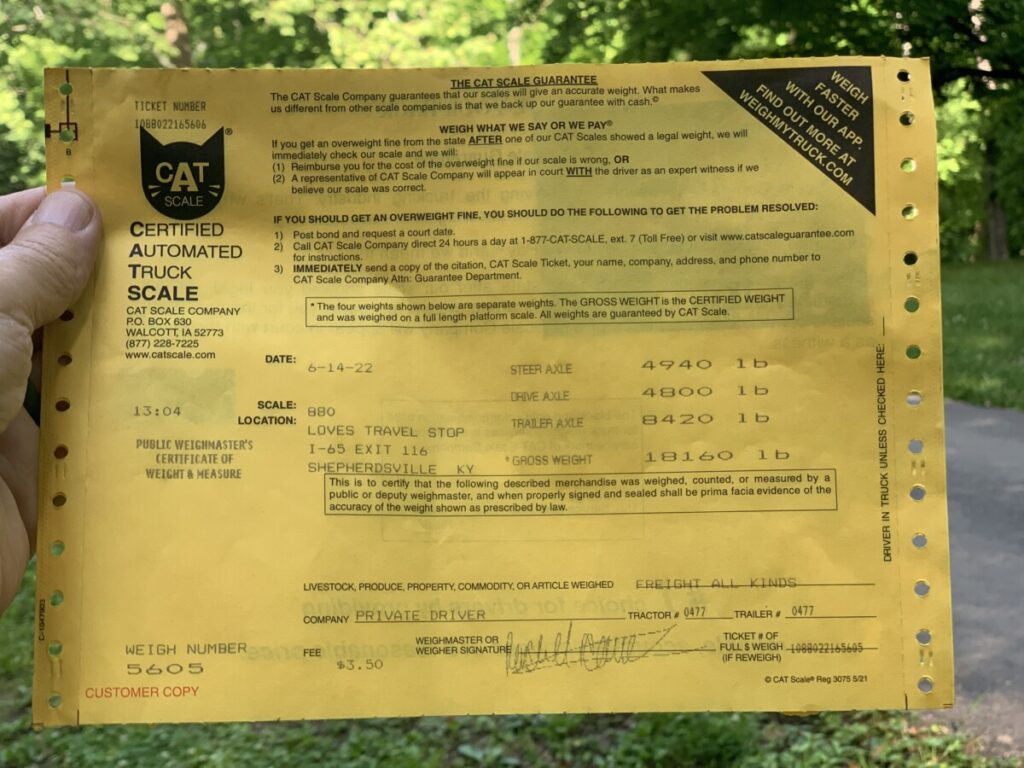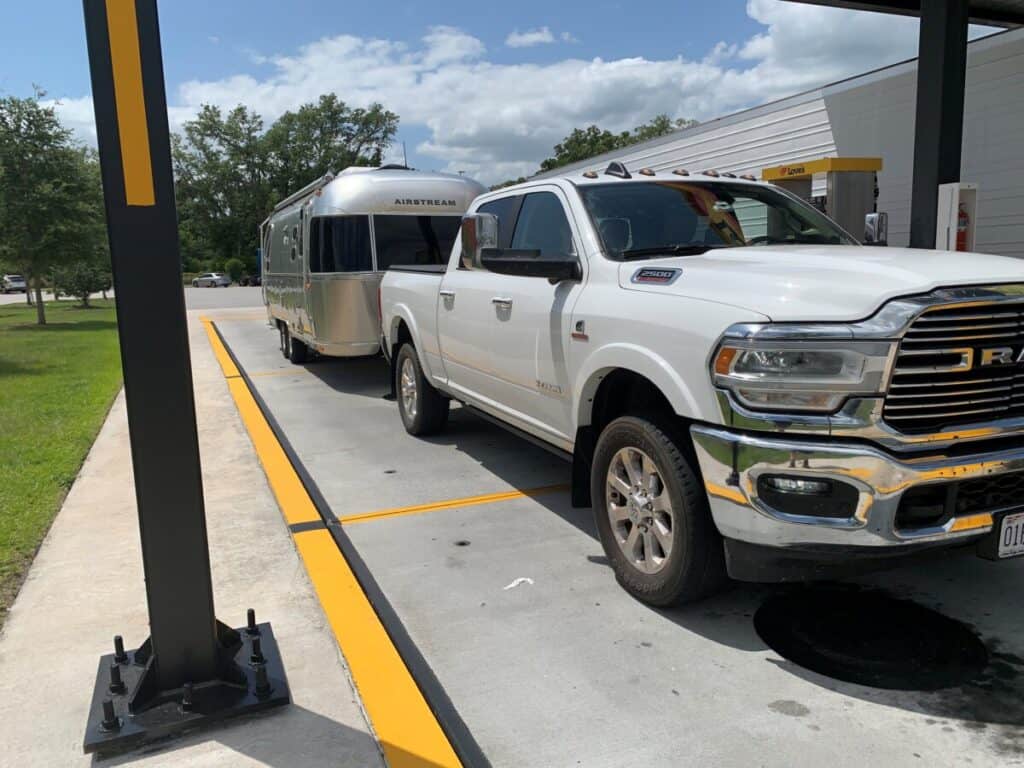
Before you go, check this out!
We have lots more on the site to show you. You've only seen one page. Check out this post which is one of the most popular of all time.
This is an updated version of my original article. In the original, I used four scales to measure the tongue weight of our 2019 25RBT Flying Cloud. We took delivery of a 2022 30RBT Classic so I repeated the experiment using the same scales and processes as before.
When I was learning to fly, weight and balance calculations were important skills to master because a correctly balanced load is critical for an airplane’s ability to maintain stable flight. As I learned about RVing and more about towing, I understood that tongue weight is similarly important to towing stability.
Tongue weight is the static, downward force a trailer tongue places on a tow vehicle’s hitch at rest, and it should fall between 10% – 15% of trailer weight. A tongue weight scale is a device placed under the tongue jack to measure the downward force exerted on the jack by the trailer’s weight.
Improper tongue weight is an unsafe condition that can result in tow vehicle damage or an accident.
If the tongue weight is too little — less than 10% of the total trailer weight – a sideways blast of wind created by passing traffic or a strong crosswind may upset the trailer’s track behind the tow vehicle and prevent it from returning to a stable state. It could cause the trailer to sway back and forth and each change in direction could be more severe than the last causing an accident. Too little tongue weight can also reduce the tow vehicle’s rear wheel traction and can cause the trailer to bounce excessively, or porpoise.

If the tongue weight is too much — greater than 15% of the total trailer weight – it could reduce the tow vehicle’s steering axle weight making the vehicle harder to control, especially while turning and braking. It could also damage the drivetrain and suspension.
Knowing the trailer’s tongue weight and its ratio to the total trailer weight is essential to safe towing and I wanted to find an accurate, inexpensive, and easy way to measure mine. I don’t know why I do this, but I seem to be pretty good at making simple things difficult. So, instead of finding a simple, clear-cut answer and looking no further, I found an opportunity to experiment.
I tested four scales and processes to find the balance of accuracy, cost, and ease of use that was right for me. The scales are listed below in my order of preference:
I used the CAT Scale first because its results would be used as the baseline for the evaluation. To get the trailer’s tongue weight on a CAT scale, weigh the tow vehicle separately, then weigh the tow vehicle/trailer combination without applying any tension to weight distribution spring bars. Add the steering and drive axle weight without the trailer, then add the steering and drive axle weight with the trailer. The difference in tow vehicle steering axle and drive axle weights is the tongue weight. Tongue weight is added to the trailer axle weight to get the total trailer weight.

Once I had the tow vehicle, trailer weight, and tongue weight from the CAT Scale, I tested other scales and compared/contrasted the results.
In the table below,the “Tongue Weight % of Baseline…” shows how close each scale matched the CAT Scale, a value that I refer to as “accuracy.” The table also shows our most useful number, the “Tongue’s % of overall weight,” a number that should fall between 10% and 15%.
Notice that in every case, my tongue weight is too light.

In addition to accuracy, I evaluated other characteristics of the tool and my assessment for each one is ranked on a 1-4 scale. I show the most preferred as a “1,” second place as a “2,” etc.

Tongue weight can be measured using a common bathroom scale, purpose-built hydraulic or analog tongue weight scales, electronic tools using an OBD2 module and smartphone (BetterWeigh), and commercial scales.
I worked with a partner and together, we bought the individual items required for the bathroom scale, etrailer, and Sherline scale methods. We did not evaluate BetterWeigh in this experiment.
Each method was evaluated against a control, the CAT Scale. I chose the CAT Scale as the control because there is only one way to use it (you drive onto it). The results are printed so there is a permanent record, and the results are certified and guaranteed accurate.
While all of the scales measured tongue weight, the CAT Scale was the only scale that provided the three weights required to calculate the tongue weight percentage – the tow vehicle alone, the tow vehicle’s weight with attached trailer, and the trailer weight.

For each scale, I recorded the cost and evaluated characteristics that include:
I assumed that the CAT Scale was going to be the most accurate because they are certified scales that come with a guarantee. We know that the weighing surface is level and that is not always possible with more manual methods. The weights are also reported in real time so there was no need to make any assumptions about trailer weight when calculating the tongue weight percentage.
The CAT Scale, etrailer, and Sherline weights were all measured at the coupler. The bathroom scale weight was taken at the jack and since weight at the jack is slightly higher than weight measured at the coupler, that may explain the bathroom scale accuracy calculation of 102%.
I found that the weight markings were not the same for each of the scales which caused us to interpolate the results for etrailer and Sherline. For example, the digital bathroom scale had a reading to tenths of a pound and the analog scale had readings to the pound. The CAT Scale also had readings to the pound, while the etrailer and Sherline scales were marked in 50-pound increments.
Compared against the baseline, readings placed Sherline as the second most accurate (1 point off), the bathroom scale as the third (2 points off), and etrailer as the fourth (4 points off). Again, Sherline and etrailer readings were interpolated so you can argue that they are effectively equally accurate. For me, the variation across all of the scales is practically insignificant – one is as good as another in terms of accuracy so my preference was based on ease of use.
I bought two bathroom scales for this test. The first one was digital and because the display’s auto-shut off complicated the test, I replaced it with an analog scale shown below (paid link). I also went to Home Depot to get a 4×4 post and a couple of 6-inch sections of 1.5 inch steel pipe for the bathroom scale set up.

The two hydraulic scales came from etrailer and Sherline. The etrailer scale is marketed directly through etrailer.com and you can check the current price here. Click here to see Sherline’s current price on Amazon.
Remember that I am an affiliate for some of the products mentioned below. I could be an affiliate for many products but, the links below are for products that I actually use, like, and recommend. By using my links, you help support this website.
When evaluating how easy each tool was to use, I looked at whether the tool could be used as a stand-alone tool or whether other items were required. I also looked at how easy it was to set up the various components and get results.
The etrailer scale is the easiest tool to measure tongue weight at the coupler because it is a single unit that can be placed directly underneath the ball socket. Sherline requires additional support at the coupler with levelers or a floor jack to bring the device to the proper height.
Sherline and etrailer were equally easy when using the device at the jack. I simply removed the jack’s footplate, placed the scale underneath, and lowered the jack until the coupler lifted off of the hitch ball.
Scalability was determined based on whether the tool could be used for multiple trailers. CAT Scales scored best in this category because there are over 2,000 locations across the U.S. and because they can accommodate any trailer our readers may pull. Sherline and etrailer tied at second because the tools themselves are easy to handle and with the 2,000 pound version, someone could use the same scale for any hitch-pulled trailer up to a gross weight of 13,300 pounds (13300 pounds*.15 = 1995 pound tongue weight).
Smart phone apps make it easy to capture weights and there are only two tools mentioned in this article that have them. The CAT Scale has the Weigh My Truck app which allows for a fast, contact-less weigh. BetterWeigh uses an ODB-II module and smart phone app. There were no smartphone interfaces to the etrailer and Sherline scales.
Storage refers to how small the tool is and how easy it is to store and transport.
The bathroom scale bundle takes up the most space and is more difficult than the others to transport. The bundle includes a scale, a six-foot long 4×4 post, two steel pipes 1.5 inches in diameter and 6 inches long, wood planks that stack to a height equal to the height of the scale, and shims to ensure that the post is level as it crosses underneath the trailer jack.
The Sherline scale is smaller than the etrailer scale so by itself, it is easier to store. But it also requires extra blocks, a stack of levelers, or floor jack to use when measuring at the coupler so when considering the whole, it falls slightly below eTrailer in my list.
The etrailer scale is roughly the same diameter as Sherline, but much longer. So, it takes up a bit more room, but we can use the etrailer scale without storing any other ancillary equipment.
I limited my evaluation of technical support to the availability and clarity of instructions, not troubleshooting or warranty. Website documentation, YouTube videos, availability of user manuals and how thorough they were, and methods for direct contact with customer service were used to evaluate a product’s strength in technical support.
The website for etrailer scales had clear, concise instructions with pictures and the site had a link to a PDF version which you can get here. The instructions are uncluttered by off-topic information.
Sherline had the most thorough documentation, almost too much for a seasoned RVer, but an outstanding resource for a new RVer or for anyone wanting a comprehensive refresh to their towing knowledge. The instruction manual covered just about every towing topic from chains, to driving in wind, and much more. While the document did not stay on topic (how to use the scale), the towing-topic was covered thoroughly, so I rated Sherline with the second-best technical support. The tongue weight instructions begin on page 10 of the manual you can get here.
Generic instructions for the bathroom scale technique were included in my Airstream user’s manual and they are easy to find online.
I rated CAT Scale last in this category because their website includes instructions on how to weigh just about any type of truck/trailer configuration, but I found no specific information from CAT Scale on how to calculate tongue weight.
All the scales set up relatively quickly, but for me, etrailer was the fastest because it required no ancillary equipment to measure at the coupler. Second place goes to Sherline because it is small but requires some type of support to place it at the proper height for measuring at the coupler. That added a small amount of time to the overall process.
The bathroom scale required us to pull out multiple pieces of hardware to set it up, so it took longer to set up than etrailer and Sherline.
Using the CAT Scale to determine tongue weight took the most time by far, as measured from pulling out of my storage unit, driving fifteen miles to the truck stop, taking multiple runs through the scale, and driving fifteen miles back.
Tongue weight by itself is only part of the question. As mentioned at the be beginning of this article, the objective is to know the tongue weight percentage of the overall trailer weight so we know if the tongue is over or under loaded.
For the tongue weight to be meaningful, we must know the tongue weight AND the total trailer weight.
For an initial tongue weight calculation, my first choice is the CAT Scale because it is the only scale that provides the three weights required to determine the tongue weight percentage and Gross Combined Vehicle Weight (GCVW) – the tow vehicle alone, the tow vehicle with trailer attached (without weight distribution), and the trailer weight.
Once I have my trailer weight from the CAT Scale, I am comfortable using that last-known weight in my calculations until a significant change to the tow vehicle or trailer triggers a reweigh. Triggers for a reweigh include:
When using my last-known trailer weight, my first choice for determining tongue weight and tongue weight percentage while at home is the etrailer scale because it is accurate, and I didn’t need any other equipment to take the measurement. It was easier to move the Sherline scale from the coupler to the trailer jack than etrailer, but neither one took a lot of time.
Second overall is the Sherline because it is just as accurate as the etrailer scale, but takes slightly more effort and extra equipment than etrailer to take a measurement at the coupler. It was easy enough to use the truck’s hitch to set the scale under the jack, but I needed extra supports or a floor jack to put the scale at the correct height to measure at the coupling.
The CAT scale takes the most time, but produces a certified, guaranteed measurement. For me, that was enough to view their results as the most accurate and to use their results as the control for this experiment. The scale reading is printed at the counter inside the truck stop so we have a well-documented written record and when using the Weigh My Truck app, a soft copy of each weigh is emailed to the address I have in my profile.

The CAT Scale is also the least expensive method, although I had to trade extra time for the dollar savings. Unlike the other methods, this is not a one-time expense, but that is okay with me.
In last place for me overall is the bathroom scale because it requires a bundle of parts that are more cumbersome to store or carry with me than I like. A setup using a bathroom scale would be fine if we had room in storage and just went on out-and-back trips, but we go out for months at a time, so it is unrealistic for me to carry a bathroom scale setup for periodic re-weighs.
Also, I used a digital scale in the first iterations of the bathroom scale experiment and my initial difficulty with that scale informed my overall impression of that method.
This article describes an experiment to find the best tool for me to calculate tongue weight and I intentionally omitted the actual process for using each scale. How we stepped through each weighing process and what we learned along the way are described in a companion article that I encourage you to read. You can find that article here.
Comparing/contrasting the bathroom scale, CAT Scale, etrailer, and Sherline scales showed that for me, the CAT Scale was the best method to capture the initial tongue and trailer weights required to calculate the tongue weight percentage. The etrailer scale is the easiest method to capture the tongue weight at the coupler, but the Sherline was easiest to record tongue weight at the jack.
Remember that I can calculate tongue weight percentage for the bathroom scale, etrailer, and Sherline only when using a last-known trailer weight recorded at the CAT Scale.
For me, there is not a best tool overall because the conditions under which I weigh, change. So, I will occasionally check all of my weights at a CAT Scale, I will rely on etrailer scale while at home, and the Sherline while on the road.
I hope that you found the results of my experiment helpful and that you find a scale and technique that you like! When calculating tongue weight, remember to measure your actual trailer weight, too, so you have a meaningful number to use when calculating tongue weight percentage.
After all, it’s the percentage that we are really after, isn’t it…
NomadicNeighborhood is a participant in the Amazon Services LLC Associates Program, an affiliate advertising program designed to provide a means for sites to earn advertising fees by advertising and linking to Amazon.com. We also participate in other affiliate programs which compensate us for referring traffic.
[wpcode id="2133"] At some point several years ago, I noticed a twinkle in my wife’s eye as we talked about using an RV to travel to National Parks and other fun destinations. As we explored...
[wpcode id="2133"] This article is part two of an experiment I conducted to see which scale and process was best for me to calculate tongue weight. In my first article, I evaluated four...